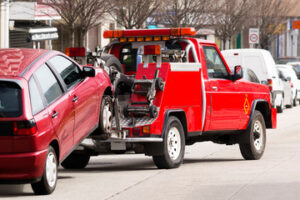When it comes to garage door repair, quality is key. If you are taking before and after photos, ensure they are of similar quality to avoid glaring differences.
For minor dents and bends, you can gently push the metal back into shape with a rubber mallet or block of wood. However, calling a professional may be necessary if the damage is more significant. Contact New Garage Door Tuttle now!

Your garage door has several springs that help counterbalance the door’s weight as it is raised and lowered. When spring breaks, the door becomes extremely difficult to open and can even cause damage to your property. A professional technician can help replace your broken spring and restore your garage door’s functionality.
When a spring is broken, you’ll first notice that your garage door isn’t opening as it should. A professional will be able to diagnose and repair this problem quickly. Depending on the type of spring your garage door uses, they may need to replace one or both of the springs.
A broken garage door spring is a serious safety hazard and should be repaired as soon as possible. These springs have a lot of bound energy that can release suddenly. This can cause the spring to snap and hit something, such as your car or the wall of your home. If this happens, it can be very dangerous for people inside the house. This is why you should always call a professional Brooklyn technician for same day garage door repair when a spring breaks.
You can also tell if a spring is broken by checking for a gap or stretched-out appearance. Springs are supposed to be tightly wound and connected end-to-end, so if they break, there will be a visible gap or stretched-out appearance. A broken spring can also lead to loose cables, which work closely with the springs to raise and lower your garage door.
While it is possible to replace your own garage door springs, you should only attempt this if you have experience working with tools and are confident in your abilities. Without the proper knowledge and skills, you can injure yourself or damage your garage door. There have been reports of people losing limbs or even their lives when trying to replace garage door springs themselves. Moreover, only fixing the effects of the problem instead of the root cause can lead to the issue returning. This can cost you more money in the long run.
Damaged Panel
A damaged panel can significantly affect the functionality of your garage door. Whether it’s from an impact caused by a car or debris or due to general wear and tear, a broken panel can quickly become a major problem if left unattended.
The first thing to determine when assessing a damage panel is whether the issue is cosmetic or structural. Does the panel have a minor ding or crack in it, or is it a large, gaping hole? Identifying the severity of the damage will help you decide whether to repair or replace it.
If the damage is only cosmetic, you can try a few DIY fixes at home. If the garage door has suffered from a significant impact or has widespread damage, however, it’s usually best to call in a professional. Garage door specialists have the expertise and tools to make quick, effective repairs and replacements with minimal disruption.
The location of the damage will also play a key role in the decision-making process. If a panel is at or near a hinge, the damage may be more serious than a simple cosmetic issue. Damage to panels at or near the hinges can compromise the way the door operates and could lead to more extensive damage down the line.
In most cases, replacing a damaged panel with a new one will be cheaper and more practical than repairing the entire door. Replacing a panel is also a longer-term solution, reducing the need for future repairs and prolonging the life of your garage door.
While you can repair or replace a damaged panel, it’s important to remember that the entire garage door is designed and built as a unit, with each individual panel working together to provide support and function. Attempting to replace just one panel can compromise the structural integrity of the whole garage door, potentially leading to further damage and costing you more in the long run. It’s always worth having a professional take a look before trying a DIY repair or replacement. They can give you a clearer picture of your garage door’s condition and recommend the right repair or replacement option.
Frayed Cable
A garage door’s cables are responsible for lifting and lowering the heavy garage doors, which means they are under a lot of stress. As a result, they are prone to wear and tear that can lead to breakages. This is especially true if they are not properly maintained. Inspecting the cables regularly and keeping them well-lubricated is essential for extending their lifespan.
If you notice that the cable appears frayed or worn out, it’s time to call for repair services. This is a serious problem that can cause the garage door to stop functioning completely or even fall to the ground. A professional technician will be able to replace the broken cable and ensure it is properly installed so that the door operates smoothly in the future.
The primary reason for cable failure is excessive usage. Your garage door opens and closes multiple times a day, placing strain on the cables each time. Over time, this can lead to a buildup of gunk that causes friction and can also cause the cable to become stretched or frayed.
Another factor that can contribute to a broken cable is exposure to the elements. If your home is located near the coast, for example, the salty sea air can corrode the metal components of your garage door, including the cables. These issues can be difficult to detect, so it’s important to have a professional inspection done on a regular basis.
Finally, a common reason for a broken cable is attempting to fix the door yourself without proper training. Garage door repairs can be extremely tricky, and if you don’t know what you’re doing it could end up costing more money than necessary in the long run. The best thing to do is to consult the door’s owner manual before attempting any fixes yourself.
In addition to avoiding the common causes of broken garage door cables, you can extend their lifespan by spraying them with a garage door lubricant on a regular basis. This will help prevent them from rusting and oxidation, which can make them weaker and more likely to break.
Broken Rollers
Although a garage door’s rollers seem like a small component of the overall system, they are crucial to its operation. As the rod-and-wheel assembly that allows your garage door to move up and down, the rollers are subjected to a lot of wear and tear. They also experience a lot of stress when the garage door opens and closes, which can shorten their lifespan.
Fortunately, you can extend their life by lubricating your garage door rollers regularly. A professional can help you determine the right lubricant to use for your specific system and can recommend the right maintenance routine to follow.
You can tell it’s time to replace your garage door rollers if they start to make grating or jerking noises while the garage door moves up and down. Over time, these noises can lead to a bent track, which further strains the garage door opener and can cause parts to break prematurely.
If you do decide to replace your broken rollers, it’s important to do so with caution. The process can be quite dangerous for an untrained individual, as the door is under a lot of tension. To prevent serious injury to yourself or damage to your property, it’s best to leave the work to a professional service provider.
In addition to replacing your garage door rollers, a professional can inspect and lubricate the tracks and other components to ensure they are functioning properly. These inspections can help you detect any potential issues that could become more serious if left unchecked.
Regular garage door maintenance is one of the best ways to avoid expensive repairs in the future. While these appointments can’t prevent all problems, they can significantly reduce the likelihood that you will need costly repair services. The most common preventative maintenance services that our technicians offer include annual track and roller inspections as well as quarterly lubrication of the tracks and rollers. To schedule your next maintenance appointment, contact the professionals at Superior Garage Doors serving Almont, Shelby Township, Sterling Heights and nearby areas today!








